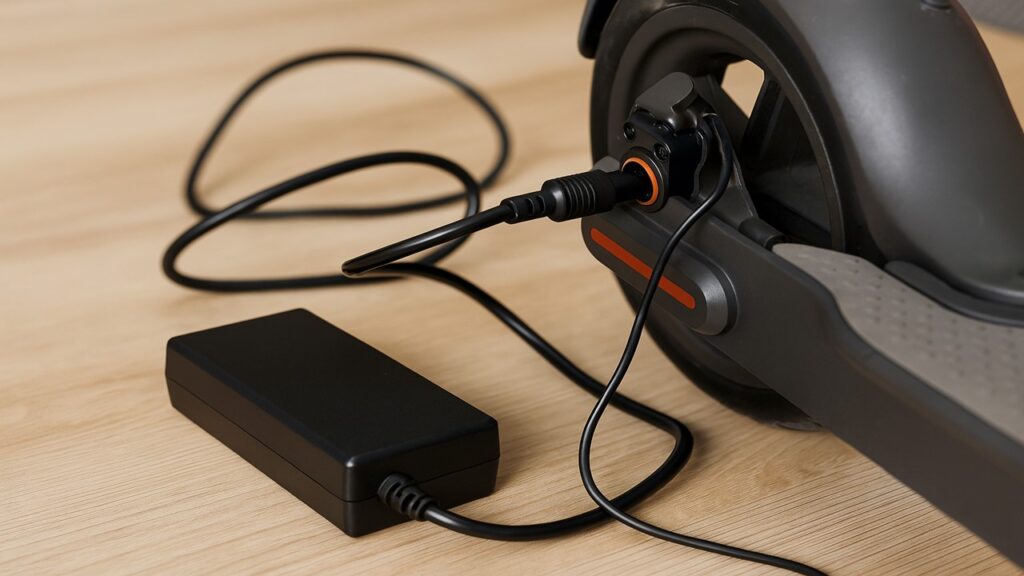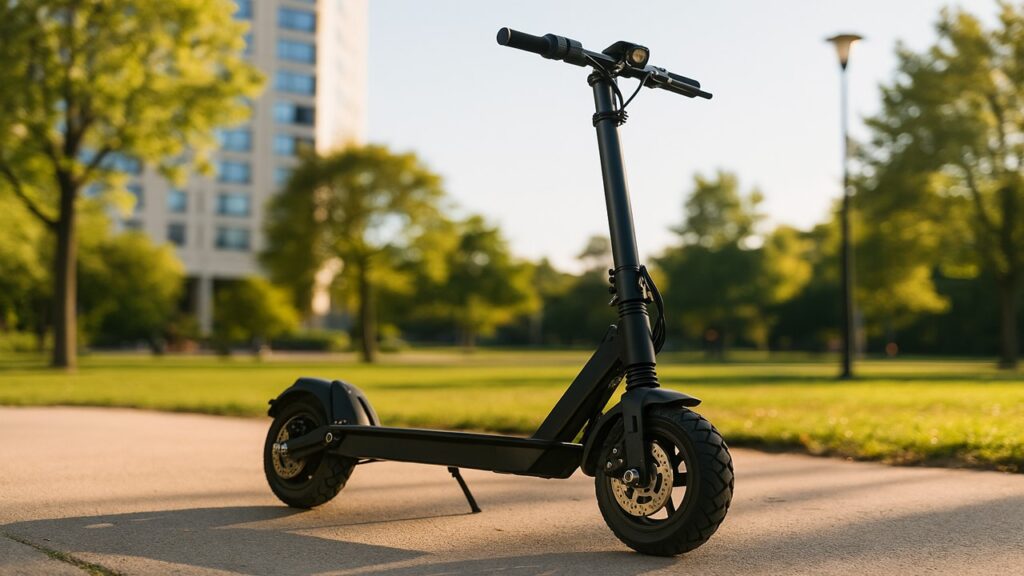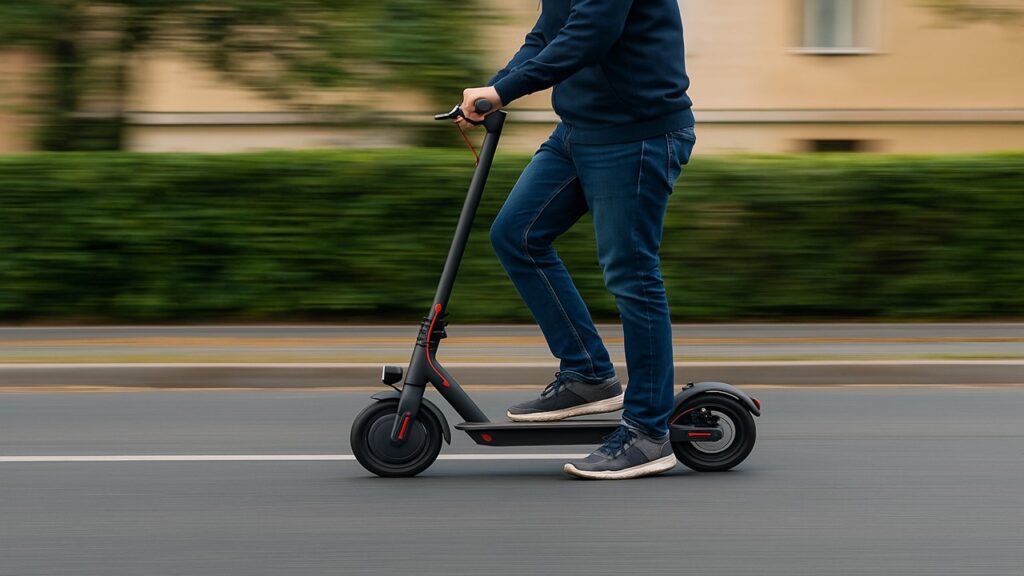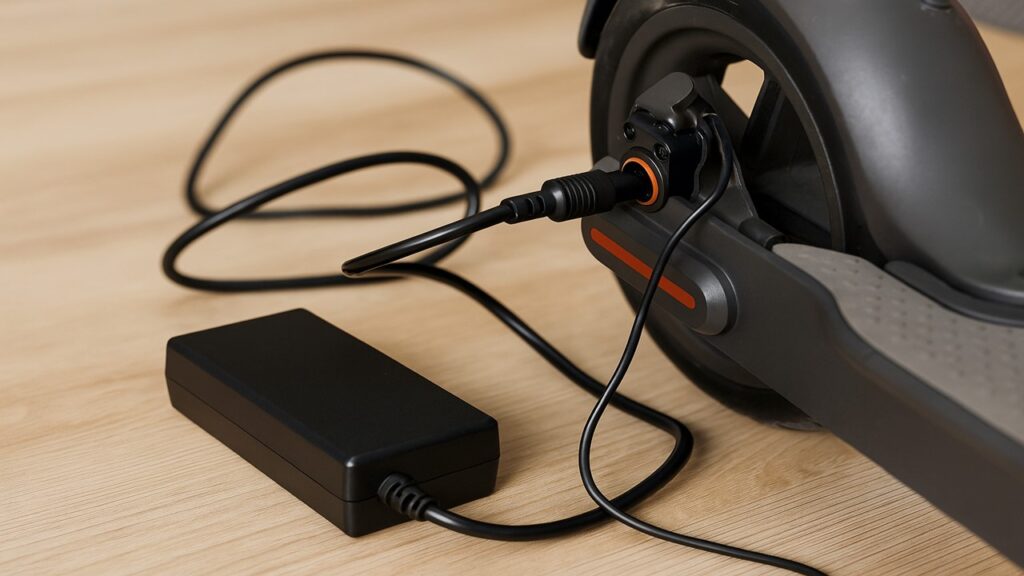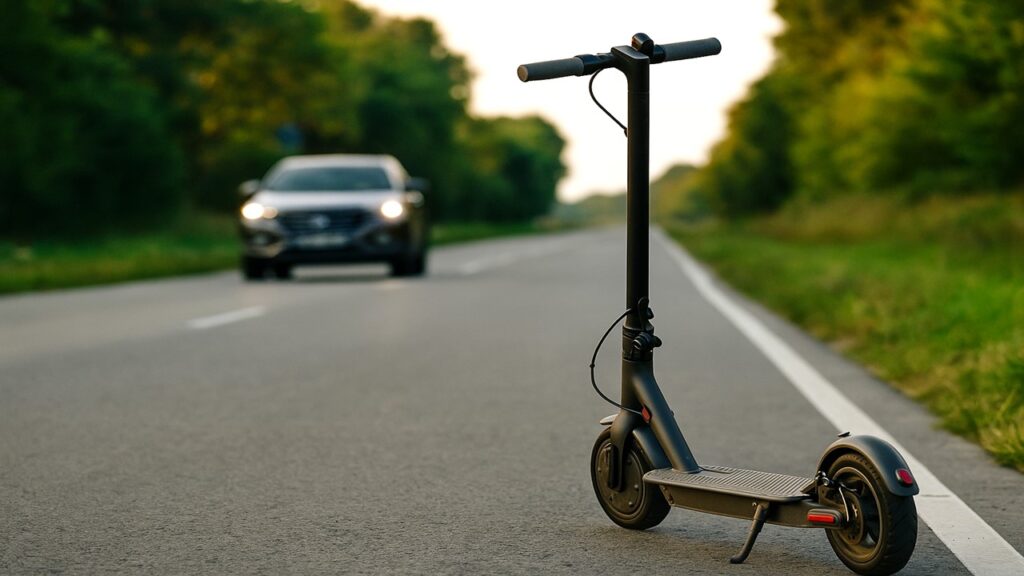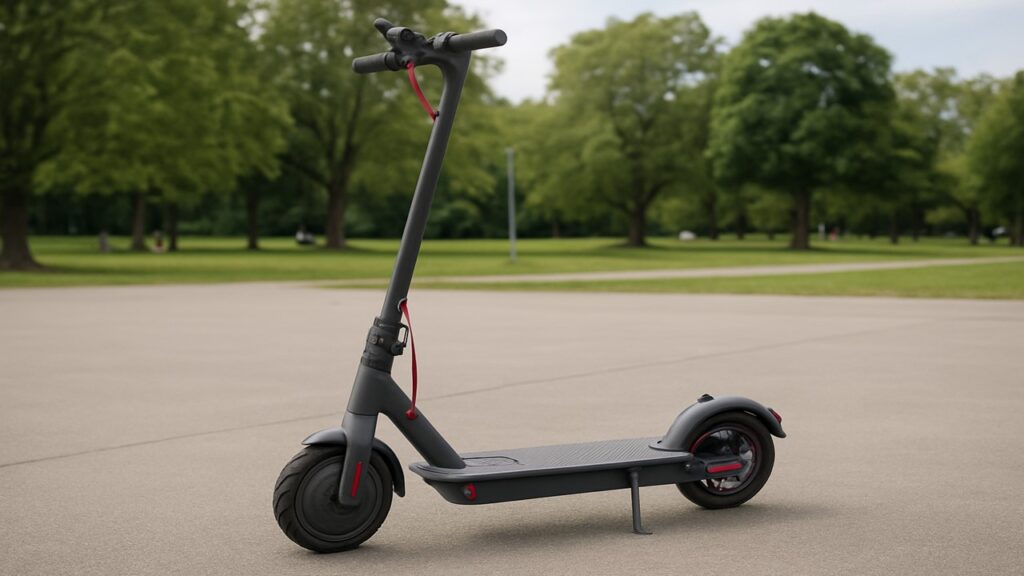
Keeping an electric scooter from being stolen comes down to layered security. By combining strong locks, smart parking choices, and modern anti-theft devices, you can make your scooter a far less appealing target for thieves.
Key Summary
- High-quality locks are the most effective first defense, with U-locks and heavy-duty chains offering far greater protection than cables.
- Parking choices play a major role in theft prevention, with visible, well-lit, and high-traffic areas discouraging most opportunistic thieves.
- Indoor storage eliminates nearly all risk, making it the most reliable way to keep a scooter safe when not in use.
- Technology like GPS trackers, alarms, and kill switches adds extra layers of security and increases recovery chances if theft occurs.
Why Electric Scooters Get Stolen
Electric scooters are attractive to thieves because they’re portable and easy to resell. Most models weigh between 25 and 35 pounds, which makes them light enough to lift into a car or carry down a street without drawing much attention. Unlike bicycles, they fold down quickly, giving thieves even more cover when making a quick getaway.
The second reason is value. Core parts like lithium-ion batteries, motors, and control units fetch hundreds of dollars on the resale market. Even if the scooter itself is too risky to sell whole, stripping it for parts can net quick profits. Combine that with the growing demand for discounted e-scooters online, and it’s easy to see why thefts are climbing.
How Thieves Steal Scooters (and How to Stop Them)
Thieves typically rely on speed and simple tools. Knowing their methods helps you counter them with stronger defenses.
- Bolt cutters vs. weak locks
Cable locks are easily cut in seconds. Hardened steel U-locks or chains dramatically slow down cutters, forcing thieves to give up. - Picking up and carrying
Lightweight scooters can be carried off even if locked by the wheel. Anchoring your scooter to an immovable object reduces this risk. - Stripping parts
Batteries, wheels, and motors can be removed quickly. Using tamper-resistant bolts or engraving identifiable marks makes resale harder. - Targeting predictable spots
Leaving your scooter in the same place every day makes it easier to plan theft. Rotating parking spots and varying times adds unpredictability.
Each tactic has a countermeasure, and combining them makes your scooter significantly harder to steal.
Best Locks for Electric Scooters
The right lock is the first line of defense. Not all locks offer the same level of protection, so choosing wisely can make a big difference.
- U-locks: Made of hardened steel, very resistant to cutting tools. Best for securing the frame to a fixed object.
- Chain locks: Heavy and durable, with thick steel links. Excellent deterrent in high-theft areas but less portable.
- Folding locks: Compact, lightweight, and stronger than cable locks. Good balance between security and convenience.
- Disc brake & grip locks: Add-on options that immobilize wheels or brakes. Useful as secondary locks but not strong enough alone.
U-Locks
U-locks remain one of the toughest options. Their solid steel build can withstand most bolt cutters. The downside is size—fitting them around thick poles or unusual structures can be tricky.
Chain Locks
Chains provide flexibility and strength. Thick, hardened links resist cutting but are heavy to carry around. Ideal for long stops or leaving a scooter overnight in monitored areas.
Folding Locks
Folding locks strike a balance. They’re easier to transport than chains, yet stronger than basic cable locks. The compact design makes them popular among commuters.
Disc Brake & Grip Locks
These locks prevent the scooter from rolling, and some models come with built-in alarms. On their own they won’t stop a thief from carrying the scooter, but as part of a layered approach they add useful resistance.
Comparison Table: Lock Options
| Lock Type | Strength | Portability | Cost Range |
| U-Lock | High | Medium | $40–$100 |
| Chain Lock | Very High | Low | $50–$120 |
| Folding Lock | Medium-High | High | $50–$90 |
| Disc/Grip Lock | Low-Medium | Very High | $20–$60 |
Smart Parking and Storage Habits
Parking choices play a major role in preventing scooter theft. Even the best lock won’t help if your scooter is left in the wrong spot. Thieves look for easy targets, so your goal is to make them think twice.
- Park in visible, high-traffic areas
Crowded spaces with constant movement discourage thieves, who prefer working unnoticed. Choosing spots near shop entrances, transit hubs, or sidewalks adds extra eyes. - Use well-lit locations
Bright light reduces cover and increases the chance someone will spot tampering. If riding at night, seek areas with overhead lamps or security lighting. - Look for surveillance cameras
Parking near a CCTV camera or building entrance creates a stronger deterrent. Thieves know they’re being recorded and are more likely to move on. - Avoid predictable routines
Parking in the same place at the same time every day makes it easy for thieves to plan. Rotate locations when possible to add unpredictability. - Never leave it overnight outdoors
The longer your scooter is exposed, the greater the risk. Overnight parking outside almost always ends badly, even with strong locks.
Keep Your Scooter Indoors Whenever Possible
Bringing your scooter indoors is one of the most effective theft prevention strategies. At work, folding scooters can often be stored under desks, in hallways, or in designated storage rooms. This removes the temptation entirely and eliminates the risks of outdoor exposure.
At home, garages, storage closets, or even inside apartments provide peace of mind. Some scooters are light enough to carry upstairs, while others offer carrying straps or satchels to make transport easier. Even if it feels inconvenient, the extra effort pays off by ensuring your scooter is safe when you’re not riding it.
Use Technology for Extra Security
Modern technology adds another protective layer beyond locks and parking. Smart devices make it harder for thieves to succeed and increase your chances of recovery if they do.
- GPS trackers
Trackers hidden inside the frame let you monitor your scooter’s location in real time. Some offer geofencing alerts if the scooter leaves a defined area. - Alarm systems
Disc lock alarms and standalone units emit loud sirens (often 120dB) when tampered with. This noise attracts attention and startles thieves. - Kill switches
Hidden switches disable the motor, making a stolen scooter useless until re-enabled. They add a strong deterrent when combined with locks. - App-based smart locks
Bluetooth and Wi-Fi locks let you lock or unlock the scooter remotely. Many integrate with smartphone apps for real-time monitoring.
Anti-Theft Devices Comparison
| Device | Key Feature | Strengths | Limitations |
| GPS Tracker | Real-time location tracking | Recovery aid, geofencing, alerts | Requires hidden placement, battery |
| Alarm System | Loud siren (≈120dB) | Deters theft instantly, alerts others | Can be disabled if found |
| Kill Switch | Motor disable | Scooter cannot be ridden | Doesn’t stop physical theft |
| Smart Lock | Remote locking via app | Convenient, monitoring options | Relies on connectivity |
Layered Security Strategy (Good / Better / Best)
Not all scooter owners face the same risk. That’s why it makes sense to think of theft prevention in layers. Even small measures can reduce your chances of becoming a target, but combining several methods creates the strongest protection.
At the most basic level, a single lock in a visible location will deter opportunists. Step up to a better setup with two locks and an alarm system to make theft far less practical. For the best defense, add a hidden GPS tracker, kill switch, and insurance coverage—this layered strategy leaves very few gaps for thieves to exploit.
Personalize and Document Your Scooter
Making your scooter unique is a simple yet powerful deterrent. Custom paintwork, decals, or engraved markings make it stand out, which makes resale riskier for thieves. A scooter that looks ordinary is easier to flip on online marketplaces, but one with distinct features is harder to move quietly.
Documentation is equally important. Record your scooter’s serial number, snap photos of distinctive features, and store receipts safely. These details are essential for filing police reports, insurance claims, and proving ownership if your scooter is recovered.
Some cities and campuses also offer voluntary registration programs. Registering your scooter adds an official record and increases the chance of it being identified if stolen. Taking this extra step often discourages thieves who prefer low-risk targets.
High-Risk Areas for Scooter Theft
Certain environments see far higher rates of scooter theft. Urban centers with business districts, nightlife areas, and transit hubs are prime spots. These locations offer plenty of cover, multiple escape routes, and a constant stream of potential targets. Thieves can blend in easily, strike quickly, and disappear in crowded surroundings.
College campuses are another hot spot. Scooters are popular among students, and predictable schedules mean long periods of unattended parking. Residential areas are not immune either—garages, driveways, and even gated communities have seen increased thefts due to complacency and reduced vigilance.
What to Do if Your Scooter Is Stolen
If your scooter does get stolen, quick action improves recovery chances. The first 24 hours are the most critical.
- File a police report immediately – Provide the serial number, photos, and receipts to establish ownership.
- Activate GPS tracking if available – Share location data with authorities rather than confronting the thief yourself.
- Search online marketplaces and pawn shops – Many stolen scooters are resold quickly.
- Alert your community – Post photos in local groups or forums to spread awareness.
Consistent follow-up in the days and weeks afterward, such as checking resale listings, staying in touch with law enforcement, and updating theft databases, keeps recovery chances alive even if it’s not found right away.
Does Insurance Cover Electric Scooter Theft?
Insurance can provide peace of mind, but coverage depends on the policy. Standard liability insurance usually doesn’t cover theft, as it’s designed only to protect against damages you cause to others. For theft protection, you need comprehensive coverage.
Comprehensive policies cover events outside of your control, including theft and vandalism. These policies may reimburse you for the scooter’s replacement value, especially important for high-end models. Premiums often start around $150 annually but vary based on scooter type, value, and added security devices.
Some insurers even offer discounts for scooters equipped with GPS trackers or alarm systems. Given that a lithium battery alone can cost hundreds of dollars to replace, insurance can be a worthwhile investment for anyone commuting daily with their scooter.
Built-in Anti-Theft Features from Popular Brands
Leading scooter brands have started integrating anti-theft technology. Segway and Xiaomi models often include Bluetooth-enabled locks and alarms that trigger if tampered with. Some even allow remote disabling through a connected smartphone app.
Unagi goes further with its membership plans, offering replacement coverage in the event of theft. These built-in protections add convenience, but they’re most effective when combined with traditional security like locks and smart parking.
How to Prevent Your Electric Scooter From Being Stolen
The key to keeping your scooter safe is to combine methods rather than relying on one. A strong lock alone will slow down thieves, but pairing it with alarms and visible parking significantly reduces risk. Indoor storage, whenever possible, eliminates exposure altogether.
Technology plays a growing role. GPS trackers and kill switches add layers of protection that make scooters harder to steal and easier to recover. Personalization—through decals, custom colors, or engravings—further discourages resale.
Ultimately, prevention is about making your scooter a less attractive target. Thieves usually look for the easiest option, so every extra step you take shifts their attention away from your ride.
Conclusion
Electric scooters are convenient and valuable, which makes them appealing to thieves. But with the right precautions, you can drastically cut your risk. Strong locks, smart parking habits, and indoor storage provide the foundation. Technology, personalization, and proper documentation add extra layers.
Insurance and built-in brand protections offer added peace of mind for high-value scooters. By combining these strategies, you make your scooter much harder to steal while keeping the freedom and convenience that make it worth owning.
FAQs
Are electric scooters easy to steal?
Yes, especially lightweight models. Thieves can lift them quickly if not secured to a fixed object.
What’s the best lock for an electric scooter?
Hardened steel U-locks and heavy-duty chain locks offer the strongest resistance to bolt cutters.
Do scooters have built-in anti-theft systems?
Some brands include alarms, app-based locks, or remote disabling, but they work best alongside physical locks.
Can I insure my scooter against theft?
Yes, but you’ll need comprehensive coverage. Basic liability policies do not cover theft.
Where do most scooter thefts happen?
Urban centers, college campuses, and residential driveways or garages are the highest-risk areas.

Max Volt is an electric scooter and e-bike enthusiast who rides daily and knows the nuts and bolts of every model. With years of hands-on repair experience and real-world testing, Max shares practical reviews, maintenance tips, and buyer guides to help riders choose the right gear with confidence. His mission is to make electric commuting safer, smarter, and more enjoyable for everyone.






